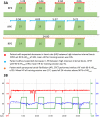Fit for Surgery-feasibility of short-course multimodal individualized prehabilitation in high-risk frail colon cancer patients prior to surgery
- PMID: 35063042
- PMCID: PMC8781359
- DOI: 10.1186/s40814-022-00967-8
Fit for Surgery-feasibility of short-course multimodal individualized prehabilitation in high-risk frail colon cancer patients prior to surgery
Abstract
Background: Prehabilitation is a promising modality for improving patient-related outcomes after major surgery; however, very little research has been done for those who may need it the most: the elderly and the frail. This study aimed to investigate the feasibility of a short course multimodal prehabilitation prior to primary surgery in high-risk, frail patients with colorectal cancer and WHO performance status I and II.
Methods: The study was conducted as a single-center, prospective one-arm feasibility study of eight patients with colon cancer between October 4, 2018, and January 14, 2019. The intervention consisted of a physical training program tailored to the patients with both high-intensity interval training and resistance training three times a week in sessions of approximately 1 h in length, for a duration of at least 4 weeks, nutritional support with protein and vitamins, a consultation with a dietician, and medical optimization prior to surgery. Feasibility was evaluated regarding recruitment, retention, compliance and adherence, acceptability, and safety. Retention was evaluated as the number of patients that completed the intervention, with a feasibility goal of 75% completing the intervention. Compliance with the high-intensity training was evaluated as the number of sessions in which the patient achieved a minimum of 4 min > 90% of their maximum heart rate and adherence as the attended out of the offered training sessions.
Results: During the study period, 64 patients were screened for eligibility, and out of nine eligible patients, eight patients were included and seven completed the intervention (mean age 80, range 66-88). Compliance to the high-intensity interval training using 90% of maximum heart rate as the monitor of intensity was difficult to measure in several patients; however, adherence to the training sessions was 87%. Compliance with nutritional support was 57%. Half the patients felt somewhat overwhelmed by the multiple appointments and six out of seven reported difficulties with the dosage of protein.
Conclusions: This one-arm feasibility study indicates that multimodal prehabilitation including high-intensity interval training can be performed by patients with colorectal cancer and WHO performance status I and II.
Trial registration: Clinicaltrials.gov : the study current feasibility study was conducted prior to the initiation of a full ongoing randomized trial registered by NCT04167436; date of registration: November 18, 2019. Retrospectively registered. No separate prospectively registration of the feasibility trial was conducted but outlined by the approved study protocol (Danish Scientific Ethical Committee SJ-607).
Keywords: Colorectal cancer; Elderly; Frail; High-intensity training; Prehabilitation.
© 2022. The Author(s).
Conflict of interest statement
The authors report no conflict of interest and are alone responsible for the content of the paper.
Figures




References
-
- Ingeholm P, Iversen L, Krarup P-M, Roikjær O, Nielsen SE, Hagemann-Madsen RH, et al. DCCG Årsrapport. 2015:2015 Available from: http://www.dccg.dk/pdf/Aarsrapport_2015.pdf.
-
- Manfredi S, Jooste V, Gay C, Faivre J, Drouillard A, Bouvier A-M. Time trends in colorectal cancer early postoperative mortality. A French 25-year population-based study. Int J Colorectal Dis. 2017;32:1725–1731. - PubMed
-
- Hamaker ME, Prins MC, Schiphorst AH, van Tuyl SAC, Pronk A, van den Bos F. Long-term changes in physical capacity after colorectal cancer treatment. J Geriatr Oncol. 2015;6:153–164. - PubMed
-
- Fagard K, Leonard S, Deschodt M, Devriendt E, Wolthuis A, Prenen H, et al. The impact of frailty on postoperative outcomes in individuals aged 65 and over undergoing elective surgery for colorectal cancer: a systematic review. J Geriatr Oncol. 2016;7:479–491. - PubMed
Associated data
LinkOut - more resources
Full Text Sources
Medical

